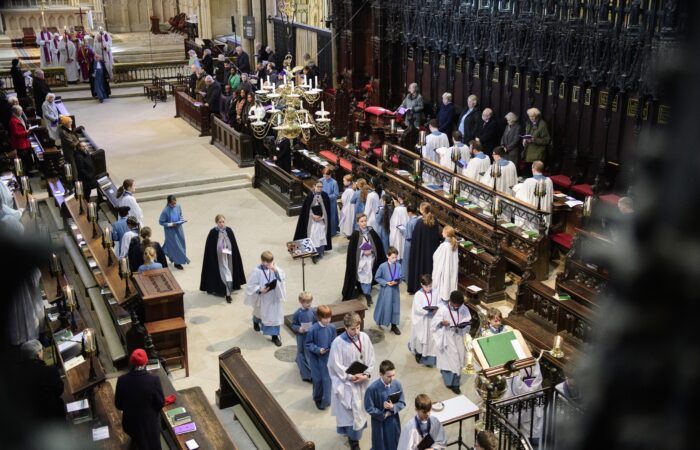Mark 14:66-72
A talk by the Canon Chancellor, the Reverend Canon Dr Mark Hocknull, first given in Lincoln Cathedral on Sunday 19 March 2017.
Hanging in the Rijk’s Museum in Amsterdam is Rembrandt’s imagining of the denial of Christ by Peter. Painted in 1660, the painting shows three central figures. In the centre of the paining is the young maid, pointing at Peter who is next to her on her left. On her right is a soldier who appears to be blocking Peter’s way. The light in the painting is centred between the maid and Peter so that Peter is half in shadow and half in light. He is trying to pull himself away from the maid and the soldier and is waving his hand as if dismissing her suggestion. His expression is complex, showing both fear and perhaps horror at the ease with which his denial of his master comes so easily to him. Over Peter’s shoulder in the murky corner of the painting the figure of Jesus can be seen being led away by the soldiers. He looks back at Peter through the gloom almost as if making one last appeal to him.
I think Rembrandt has caught something very profound in this image. It’s almost as if Peter sees himself in his true light for the first time. As if even in the moment of denial Peter is remembering the promise to stay true and to die with Jesus even when all the others desert him. A moment of self-recognition when Peter realises that he has over estimated his courage.
The story of the denial of Jesus is the last episode in Mark’s gospel in which Peter appears. The vocabulary that Mark uses and some of the ideas he deploys though are reminders of Peter’s very first appearance in Mark’s Gospel. In that episode of course peter is still called Simon. At the very beginning of the Gospel, Mark tells us that Jesus comes from Nazareth in Galilee and that he summons Simon and the other fishermen to follow him. They follow him immediately we are told, they leave everything behind and follow Jesus without a second thought. Come now to this last episode. Here Peter follows the arrested Jesus, but at a safe distance in order not to get involved. He denies knowledge of Jesus of Nazareth and he refuses to acknowledge his own identity as a Galilean. Where at the beginning, he follows immediately, now at the end when he denies Jesus the cock crows immediately. Where at the beginning, he leaves everything for Jesus’ sake, now at the end, he loses everything of real worth for his own sake.
The change of names is very significant. In ancient Hebrew thought names were very important and amongst other things were meant to indicate the character of the person bearing the name. Simon means reed, as in the tall grass-like plants growing at the water margins. Reeds bend and sway with the wind, they ‘go with the flow’ and are easily broken and crushed. Peter means rock. It is the root of our English verb petrify, to turn to stone. Rock is strong, solid not easily moved or broken, dependable and able to serve as a firm foundation. His final appearance in the Gospel of Mark reveals Peter not to be the solid dependable faithful disciple after all, but Simon the reed, easily broken and bending in the wind of threat and menace. It all looks as though Peter’s change of name is some kind of joke on the part of Jesus. The picture of one of tragic reversal, of so much promise unfulfilled and a brilliant beginning thrown away. It is a picture of love’s labours lost. Peter you see is denying more than Jesus. He is turning his back on the identity which Jesus has given him.
How can he have come to such a place? Mark hints perhaps that Peter’s fatal flaw is an inability to learn from experience. He is given ample opportunity to grasp the meaning of Jesus throughout the gospel. With admirable insight Peter is the first of the disciples to recognise Jesus as the Messiah, but when Jesus begins to talk about the Messiah suffering and dying Peter rejects the idea and is told by Jesus that he is not thinking clearly. Peter with James and John is present at the raising of Jairus’ daughter. He knows that with Jesus death is not the end. He has been given a demonstration of the death-defeating power that is at work in Jesus. Peter has not learnt. He cannot learn what Jesus is trying to teach and what the Gospel itself is about. No doubt Peter was flattered by his name change and no doubt he tried his best to live up to it. But he over estimates his abilities and in the end, his fatal flaw brings him down. He is not Peter but simply Simon. He plays no further part in Mark’s story of Jesus.
There is however a single ray of hope. It comes not from Peter, but from Jesus’ words to all the disciples at the last supper. “Nevertheless, after I am raised I shall go ahead of you into Galilee.” This promise is reiterated by the angel at the empty tomb. To the three women at the tomb, the angel says “but go and say to his disciples and to Peter ‘He is going ahead of you into Galilee: there you will see him as he told you.’” That “and to Peter,’ is the single ray of hope. Peter does not reappear in person in the story, but his name does. In spite of the threefold denial, Peter is not cut off from grace. Love’s labour is not lost. Grace abounds for the chief of sinners. He is yet Peter, if he is willing to become a follower once again of the one who goes ahead to Galilee and to what Galilee represents: revelation, mission and a new way of life. This time however he must be peter not in his own strength and effort. He must let God and let the power and strength of the risen Christ flow through his life. Stop thinking in terms of his plans and what he thinks he should do, or what others have told him to do. Instead listen to Jesus and follow him. What Peter has to learn is let go his old misunderstanding and break though into the new knowledge of the risen Christ.
Since Lent is a time for self-examination and growth in self-understanding, then the story in Mark of Peter’s denial is a valuable place to pause and reflect, long and hard. It helps us to see how easy it is to be a kind of fair-weather friend when it comes to believing and obeying god and following Jesus. When the storm comes, we sink, when the moment to bear witness arrives, we fail. The time of testing for most us is the passing moment which we hardly notice. Moments of truth when through some insignificant encounter we show whether we belong to Christ or not. The short-tempered exchange or the passing of an opportunity, perhaps over a cup of coffee, to own up to our faith for fear of seeming simple-minded or naïve or foolish or pious.
Mark’s story of Peter is a bleak one and we should take time this Lent to allow that story in all its bleakness to hold our unflinching attention at least for a little while. For true resurrection can come only after a real dying. In the end though there is hope, even in Mark’s account for Peter remembers what Jesus had said and weeps. The act of remembrance is an act of turning to a point of reference. In remembering we turn to our point of reference, the passion and resurrection of Jesus. And in doing so we are not only judged but more importantly reconstituted, brought again from death to life.
The Canon Chancellor will continue his series of Lent Talks at Evensong on each Sunday of Lent. Evensong on a Sunday begins at 3.45pm and is held in the Choir of Lincoln Cathedral.

